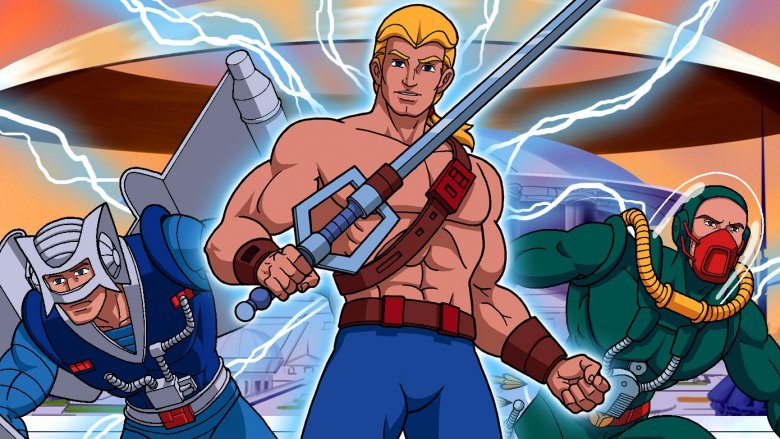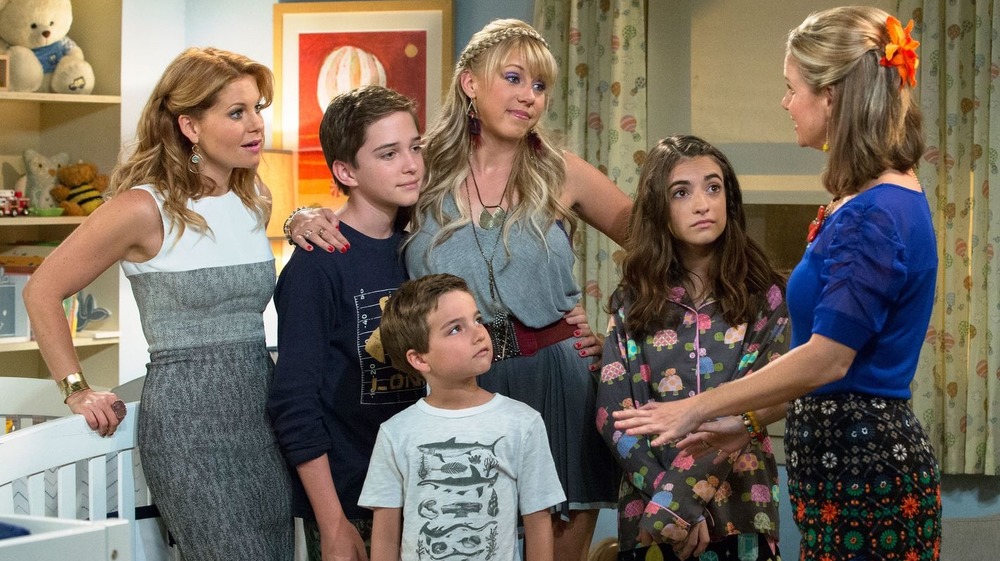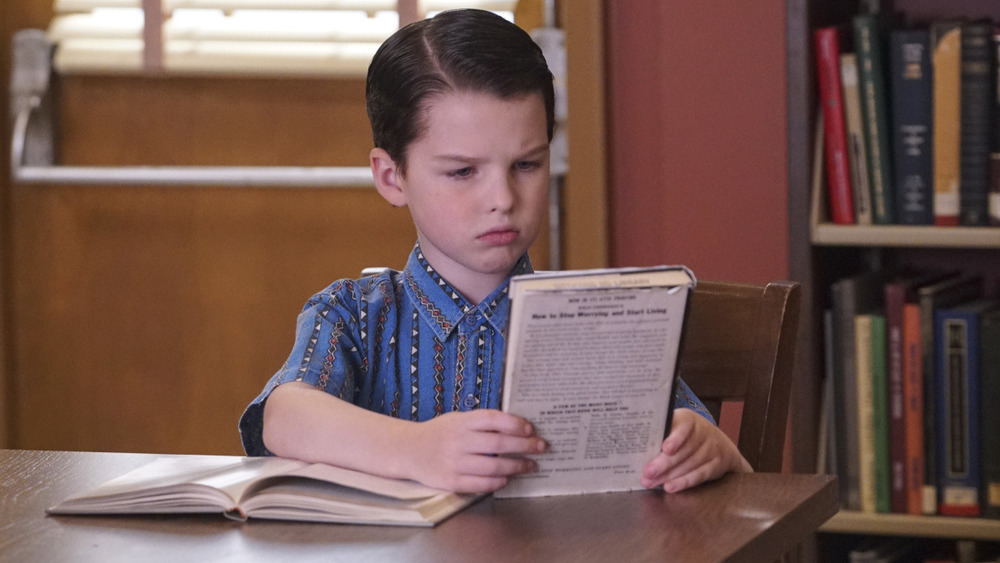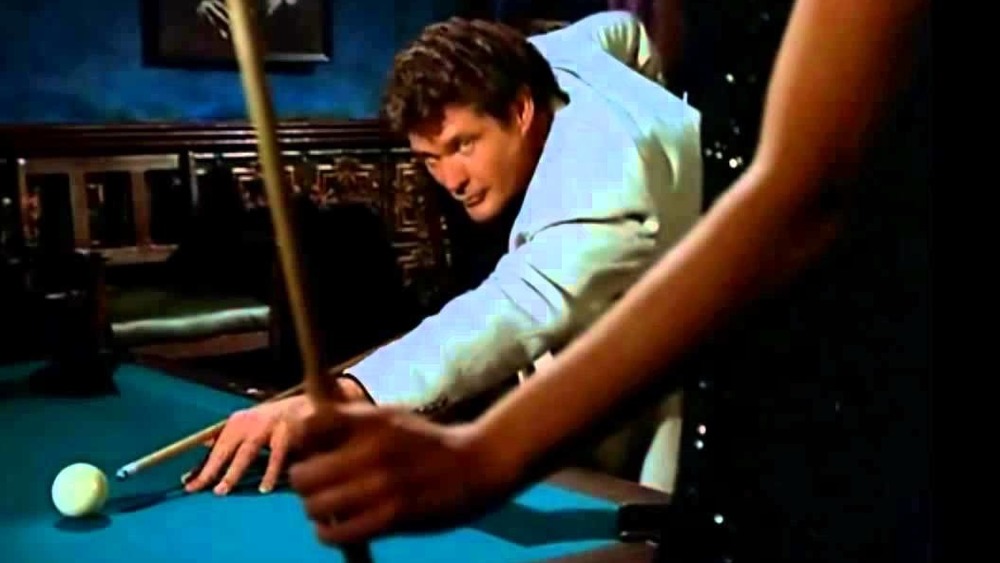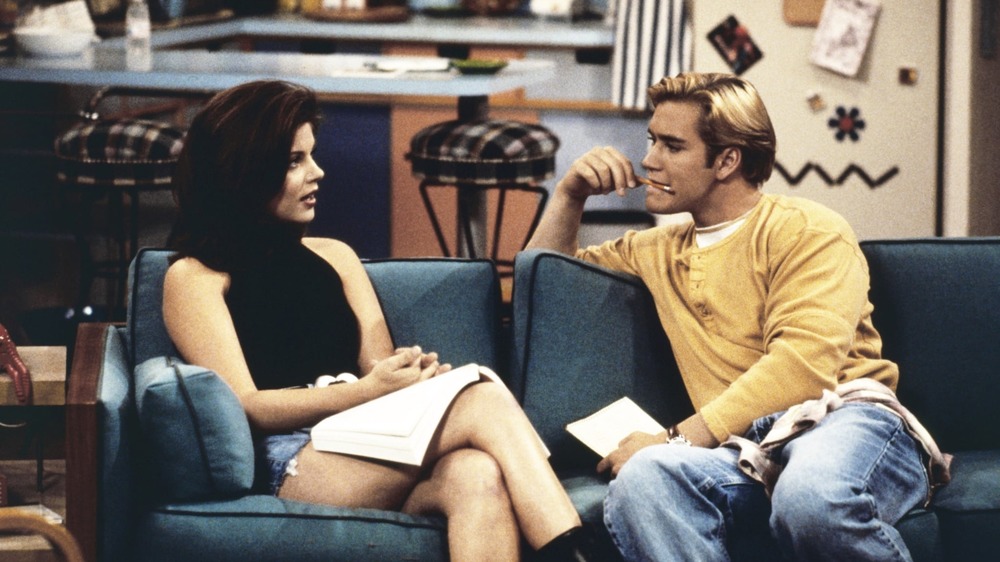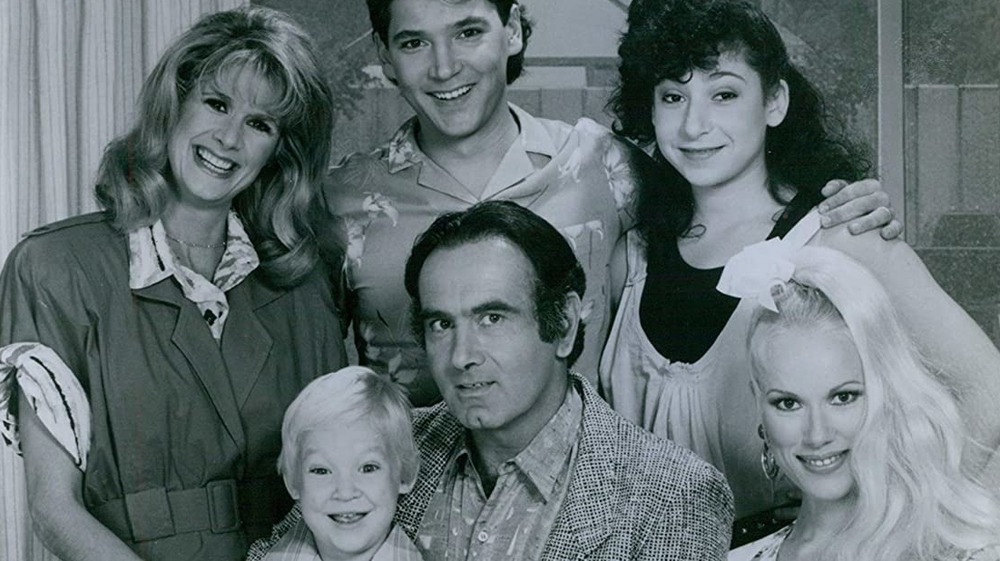Unbelievably Lazy TV Spinoffs
There's something compelling about getting to explore a new corner of an established fictional universe, and TV spinoffs sate that curiosity about as well as anything. From Frasier to Better Call Saul, a great TV spinoff can expand on the inner lives of supporting characters, flesh out the world the showrunners have built, or just give fans more of what they love. Unfortunately, given that spinoffs tend to come with a built-in audience, it's easy for network executives to lazily crank out a haphazard cash grab instead of a thoughtful, well-crafted extension of a property viewers love. Here are some of the most egregiously lazy TV spinoffs of all time.
That '80s Show (2002)
The logic behind the creation of That '80s Show seems to have been, "Hey, people seem to love That '70s Show! Let's do that, but a decade later." as though what drew viewers to That '70s Show was the fact that it was a period piece and not, well, everything else about the show. That '70s Show thrived as a charming high school comedy with a lot of heart that seemed to utilize its being set 30 years before it aired as a device through which to explore the similarities and differences between growing up in the '70s versus the late '90s/early aughts. Its spinoff had none of that charm.
That '80s Show premiered in 2002 at the height of That '70s Show's popularity, but there's practically zero connection between the two shows. Not a single character from That '70s Show appeared in any of That '80s Show's 13 episodes, nor did it take place in the same town, instead opting for San Diego, California as a setting. The only vague connection between the two? The protagonist of '80s Show was a cousin of Eric Foreman, protagonist of '70s Show. Its tackiness is palpable just from watching the first few minutes of the pilot. You get the feeling that the only reason it was marketed as a spinoff at all is because nobody would have given it a second look without name recognition.
The Brady Bunch Hour (1976-77)
One of the more infamous TV spinoffs of all time, The Brady Bunch Hour is at the very least interesting despite (or perhaps because of) its general insanity. A direct continuation of the family sitcom, the show featured the Bradys as hosts and stars of a variety show that aired within the universe of The Brady Bunch. It featured song, dance, and synchronized swimming as well as "behind the scenes" segments taking place in the Brady home. The result is a surreal trainwreck.
It's a clear example of a show's brand being expanded into territory it doesn't fit into. There's no logical reason the characters on the original show would have been given a variety show in their canonical timeline. They're just an average American family, after all. But variety shows were big at the time and the show seems like an opportunistic ploy at expanding the Brady Brand into that market after reruns of the show garnered huge ratings in syndication. Admittedly, handing showrunning duties to Sid and Marty Krofft (the creators of bizarre puppet program H.R Pufnstuf) could have made for an inspired program. Nonetheless, after a big debut, audience enthusiasm plummeted and the show was cancelled after nine episodes.
Fuller House (2016-2020)
We live in the era of the TV show revival, with everything from canceled-too-soon favorites like Arrested Development to classics with long original runs like The X-Files being brought back for new seasons. We're lucky. A lot of these shows are very good, and some are even great. But for every Twin Peaks: The Return, there's a Fuller House, a show that advertises its more-of-the-sameness in its very title.
It's hard to watch the show and not wonder who it was made for. The show, which is produced through Netflix, is a shameless cash grab that catches readers up with the Tanner family nearly 20 years after we first met them. To watch it is to be constantly reminded that there's a reason sitcoms have evolved since the '80s and '90s. It's clear from the first episode that the characters, their stories, and the structure of the show is very much a product of its time. As such, the show relies far more on audiences tuning in to see a possible Uncle Jesse guest spot than for the tired humor that was the original series' trademark. That being said, if the show is a cash grab, it's certainly accomplishing its goal — it aired for five wildly popular seasons.
Young Sheldon (2017-present)
Despite the rampant criticism lobbied its way, The Big Bang Theory has its fair share of fans (to say the very least). This is thanks in no small part to actor Jim Parsons' breakout role as Sheldon Cooper, a performance for which Parsons has won numerous awards. Sheldon is a genius savant who struggles with socializing but excels at sciences and math. He's also largely responsible for the show's inescapable catchphrase, "Bazinga!" That being said, it's pretty hard to see 2017's Big Bang Theory spinoff Young Sheldon as anything other than a brazen appeal to the lowest common denominator.
In the interest of giving credit where it's due, it's not like the showrunners just lifted the premise of Big Bang Theory and restructured it to suit a new incarnation of Sheldon. The show is recognizably different. It's a period piece set in the late '80s and early '90s, focusing on 9-year-old Sheldon's adventures as he begins high school, having been placed there due to his advanced intellect. It is, arguably, a more compelling premise than that of the show from which it's spun (what if nerds lived across the hall from an attractive girl?) but that doesn't make it any less shamelessly lazy.
The New Adventures of He-Man (1990)
Masters of the Universe has always been a product first and a fictional universe second. Its very beginnings stem from Mattel trying to create a toy series that would appeal to young boys. The ensuing world of stories starring the warriors of Eternia, fun as they may be, have always been a secondary priority. This isn't to say the world of He-Man isn't awesome — the characters remain popular for a reason, even inspiring an annual fan convention. It's just important to remember that it's never been a primarily creative endeavor. That makes reconciling the existence of The New Adventures of He-Man a little easier.
Created in an attempt to revive the brand in the wake of the toy line being discontinued in 1987, The New Adventures of He-Man reimagined the world of Eternia in a science fiction environment. It's weird, to say the least. He-Man has a ponytail, while his archnemesis Skeletor winds up with a character design that makes him look more like the Mask than an avatar of evil. Despite running for over 60 episodes, it worked in tandem with lousy toy sales to tank the franchise, which wouldn't be seen on TV again for another twelve years. We'll give it this: the animation is far superior to the original series. But that's where the praise ends.
The Girl from U.N.C.L.E (1966-67)
The Man From U.N.C.L.E was a massively successful action-espionage series in the '60s. Its popularity spawned everything from imitators to the first real television fandom. The adventures of suave American agent Napoleon Solo and gruff Russian agent Illya Kuryakin remain excellent television; unfortunately, its imitators included an official spinoff titled The Girl From U.N.C.L.E. Let's just say there's a reason that the former has received a modern blockbuster adaptation and the latter is rarely spoken of.
When a show is as big a hit as The Man from U.N.C.L.E., a spinoff makes total sense. Unfortunately, Girl is about as phoned-in as they come. It focuses on U.N.C.L.E agent April Dancer and her British cohort Mark Slate, neither of whom have any connection to the characters from the original series aside from their place of employment. Rather than the realism and tension of its predecessor, Girl leaned further into camp and comedy, a tone that didn't resonate with audiences. It was a dud and ended up canceled after just one season.
Joey (2004-06)
Friends projected its entire cast into superstardom. However, when he show wrapped up it was Matt Leblanc's Joey Tribbiani, the dim-witted but lovable working actor, who was given his own spinoff, simply titled Joey. It ran for two seasons — two seasons more than it should have.
That a spinoff happened is understandable. Friends was a massive cash cow for NBC, so it completely makes sense that they'd try to prolong that success even after the show wrapped up. But in centering the spinoff on just one of the main cast members, they failed to consider that what made Friends so popular to begin with was the whole ensemble. It was all about the way they played off one another. Taking one cast member and sticking them in a new setting with new characters was an embarrassingly indifferent decision — especially when that character is Joey, who served largely as comic relief. Focus a show on him, and all you've got is an airhead doofus and some one-note supporting characters. There's probably an idea for a witty, charming Friends spinoff out there somewhere. Joey isn't it.
Baywatch Nights (1995-97)
As far as spinoffs go, this one is pretty blatant in its apathy. Baywatch, mind you, is to this day a cultural landmark. It gave David Hasselhoff life after Knight Rider, and made Pamela Anderson a worldwide star. It made running down the beach in slow motion a modern trope. It's cotton candy in TV form, and we mean that in the best way possible. Its spinoff, Baywatch Nights, is a whole different story.
Rarely does a spinoff get as weird as Baywatch Nights. Its initial premise — that Hasselhoff's Mitch Buchannon and friends join a detective agency — is weird enough. Half of the appeal of Baywatch came in its beach shenanigans and its attractive cast running around in swimsuits, and a detective agency decidedly nixed both of those factors. But then came the utterly bizarre second season, which took notes from a popular but decidedly different program: The X-Files. Buchannon and company's cases now took a paranormal turn, even including aliens at times. At this point the show barely resembled its source material, and viewers never followed. It was axed after its second season. This one isn't good by any means, but it's a bizarre viewing experience that's at least worth a quick watch.
Saved by the Bell: The College Years (1993-94)
The thing about high school comedies is that they're at their best when they're about, well, high school. Much of the comedy in shows like the original Saved by the Bell stems from characters like Slater, Zack, and Kelly coping with very lighthearted, relatable high-school-specific struggles, save for those Very Special Episodes about, say, the horrors of addiction. Furthermore, the reason shows like these resonate is because the target audience, largely made up of middle and high-school kids, identify with the situations the characters find themselves in. Trying to transfer this to a college setting rarely works — and rarely does it fail as spectacularly as it did in Saved by the Bell: The College Years.
The College Years is a crash course in making a dull spinoff. It hits all the right notes: changing a show's setting without changing its formula to match, separating the core cast and therefore disrupting the chemistry that made the show great to begin with (No more Zack and Kelly? Why even watch?), and introducing a slew of new characters that no one cares about. The College Years also aired during primetime rather than on Saturday mornings, putting a lousy show up against much stiffer competition. The result is a show that could have been fun, if not for the rampant carelessness behind its creation.
After MASH (1983-85)
A terrible pun is probably a bad way to start the spinoff of one of the most popular television shows of all time (the aftermath of M*A*S*H, after-mash, get it?), but that was only the start of AfterMASH's problems.
The original series remains an all-time classic, with its series finale remaining the single most-watched non-sports television event of all time. It followed a group of servicemen and women working in an army hospital during the Korean War and frequently explored timely issues while never sacrificing its tone, heart, or comedy. M*A*S*H ran for just over 250 episodes, and it's understandable that executives would want to stretch the show's success out a little further. Unfortunately, AfterMASH failed spectacularly.
Following the lives of its characters after the war, there's only one word needed to describe AfterMASH: stale. The show took a handful of favorite characters and depicted them in a hospital for veterans, which proved significantly less exciting than their exploits during the war. The series got the axe after a dreadfully received second season that saw it getting creamed in the ratings by The A-Team, and stands as a testament to the fact that some shows are best when left to their proper endings.
The Tortellis (1987)
Cheers actually ended up being the parent program of a pretty great spinoff: Frasier was so successful that it's sometimes easy to forget it came from Cheers to begin with. Some characters from Cheers even went on to be featured in guest spots on unrelated shows, including Wings and St. Elsewhere. It's one of the most famous sitcoms of all time and featured a wide cast of zany characters, many of whom could likely have had their own successful shows. We'd even wager to say that any of them could launch a show tomorrow, and it would still be better than the first-ever Cheers spinoff: the disaster that is The Tortellis.
There's almost an arrogance to the decision to make the show to begin with. The showrunners seem to have assumed Cheers was so successful that even the most despicable character could sustain his own series. Nick Tortelli is a womanizing sleaze who makes his ex-wife Carla miserable every time he shows up on the show. He worked great as an antagonistic foil every now and then, but to give him and his trophy wife Loretta a show in which she leaves him and he follows her to Vegas to win her back is a lousy idea, not to mention lazy to boot. The show failed to make Nick likable — and failed to make it past its first 13 episodes.
